Genealogy Menu
Cahermaculick Today and Yesterday
Often I think of where I was born and the family home in the townland of Cahermaculick in the parish of Kilmaine, County Mayo, Ireland*. Whenever I return there, despite my willingness to acknowledge the very significant improvements in the lifestyle of its people, I privately bemoan the demise of tillage in favour of dry stock, where all you see are cattle or sheep in green field after green field with the word ‘herding' being freely used to convey its modern connotations of vets, artificial insemination, motorised buggies and an array of tractors as against those of the past when simple caring on foot was all it took. Today, it's so uncomfortable to walk across the fields to childhood haunts because of the unevenness, the hoof holes and the mud caused by herds of cows and other stock. Gone are many of the woodlands and the hedges of blackthorn and hawthorn that once separated the meadows, the lakes and ponds, the fields of oats and barley, wheat and potatoes and all those drills of carrots, parsnips, cabbages, and onions. Gone through organised drainage is the lake as well as the unending lines of wild daffodils that stood so colourfully and majestically along its northern foreshores. As you came over the small hill between our home and the lake, this large expanse of wild daffodils came into view as a beautiful golden carpet. The contrast was breath-taking! I was first introduced to Wordsworth's Daffodils when I was away in college in Cork as a young teenager. This poem nearly said it all for me.
* Its postal address is Cahermaculick, Shrule, Co. Mayo.
1 wander'd lonely as a cloud
That floats on high o'er vales and hills,
When all at once I saw a crowd,
A host of golden daffodils,
Beside the lake, beneath the trees,
Fluttering and dancing in the breeze
Continuous as the stars that shine
And twinkle on the Milky Way,
They stretch'd in never-ending line
Along the margin of a bay:
Ten thousand saw I at a glance,
Tossing their heads in sprightly dance.
The waves beside them danced, but they
Qutdid the sparkling waves in glee:
A poet could not but be gay
In such a jocund company!
I gazed-and gazed-but little thought
What wealth the show to me had brought;
For oft, when on my couch I lie
In vacant or in pensive mood,
They flash upon that inward eye
Which is the bliss of solitude;
And then my heart with pleasure fills,
And dances with the daffodils.
Missing, however, was our wandering through the thousands of wild daffodils that were taller than we in order to observe the many birds' nests they concealed. The flights past our home of large flocks of birds, including wild ducks, geese and swans on their way to and from the lake were daily occurrences.
The local community, like all other communities throughout Ireland, has so many stories that will never make the history books. Its history, as well as that of the Irish nation, and its rich folklore has always fascinated me, despite my living on the other side of the world, because through them I am able to link with my roots and enjoy that feeling of family continuity which is so important to me.
There is, however, no way that our family's way of life when I was a child will ever be known to you unless I provide a few windows through which you can see for yourself a world that was so different from your own. Ours was a farming neighbourhood with its own style of mixed farming that was quite labour intensive and involved everyone in the household. You bred and reared your own fowl and stock and when the time was right sold most of them at the local fairs. Hens, ducks, geese and turkeys roamed the yards alongside every house right across the countryside. All the tiny chickens, ducklings and goslings were forever a great source of joy and fascination to us as children. We didn't have to read about them in books. We were there for their hatching and their breaking through the shells, captivated by their taking that first step or beakful of milk or meal. The young piglets, or bonhams (from the Irish ‘banbh') as they were called, were equally captivating as were the young lambs in springtime as they played and cavorted their way around their feeding mothers.
Whenever I visit a fruit shop or the nicely arranged fruit shelves in super markets and shopping centres where in many instances it all only looks so fresh, I recall the beautiful orchards in the village of my childhood and all that very fresh and crunchy fruit. Alongside just about every home were a well-kept orchard and a vegetable garden the likes I have not seen since in all my visits to Ireland. It is so hard today to imagine their ever being there. The people were very proud of their orchards and gardens, and indeed very protective of them, particularly the orchards that were often the target of well planned incursions by the local youth on their way home from school. This rural structure of small farms of between thirty and forty acres coincided with the removal of the English and their semi feudal system from most of Ireland during the first quarter of the twentieth century. Prior to this development, most of the Irish people were huddled into small villages where the average family was forced to exist on between one to five acres of land rented from the local landlord. This land was usually the least arable in the region. Towards the end of the 19th Century some tenants with good rent-paying records were allowed to rent a few extra acres.
During my childhood and indeed into the early seventies, the countryside was ever changing its patchwork design with equal variegation to announce the seasons. Back then, a glance at the countryside proclaimed the seasons, spoke of the greatness and possibilities of nature and made you so aware of its ability to just be itself in so many different and wonderful ways. This patchwork design was made all the more conspicuous by the large number of small fields and the diversity of crops that were constantly changing in both form and colour throughout the spring, summer and autumn months. Often, as I reflect on the themes of Seamus Heaney's or Gerard Manly Hopkins's nature poetry, I wonder what it evokes or conjures up for the modern reader in its very reverent enthusiasm for the activities of the seasons, given now that those activities no longer exist; or is it as these lines suggest 'the soil/Is bare now , nor can foot feel , being shod'.
Today, sadly, the changes are confined to merely the climate and hours of daylight. The countryside changes little throughout the year. Gone to a large extent is the habitat with its fauna and birds and to a certain extent its flora that so enriched one's life. The cuckoo, the corncrake and the skylark that gave voice to the life of spring and summer are rarely to be heard. All this and so much more that were wonderful parts of the fabric of life back then in the 1940's and 50's are no more. The organic crops and drills of vegetables that once sustained a healthy lifestyle are now replaced by imported foodstuffs in tins and plastic wrappings. Modern consumerism greets you even in the most remote of boreens as a continuous reminder of the price of progress. All that was worthwhile about the older way of life has been pushed aside to make way for the new, repeating once more the mistake made by so many of the other western countries.
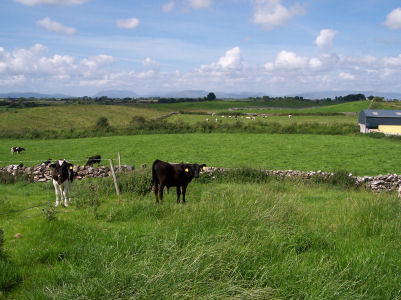
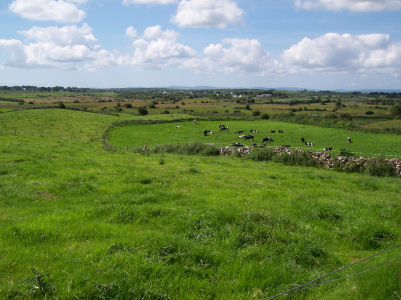
Today mainly grazing and dairying across the country in contrast to tillage in the 40's & 50's
|
|
|
|
|
|
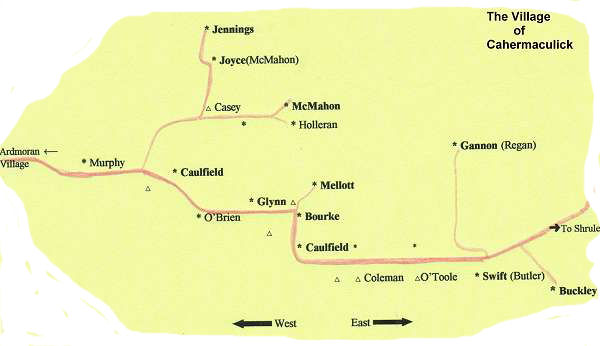

 Field below the House Field below the House |
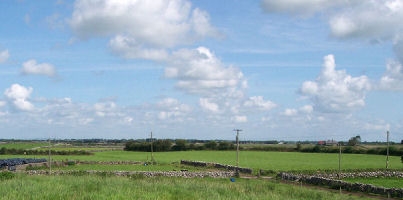 Big Meadow beyond the House Big Meadow beyond the House |
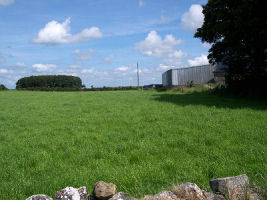 Field behind the house Field behind the house |
 Field above the House Field above the House |
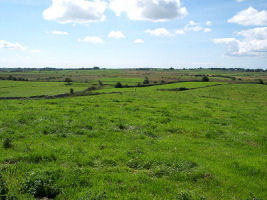 The High Meadow from the Hill |
Cahermaculick did not exist as a village until the second decade of the twentieth century. Up until then it was part of the thousands of acres controlled by Lord Kilmaine* and his family. In the 1940's and 50's, the Townland of Cahermaculick had seventeen farming families whose names are shown in this diagram. All the families in bold print have died out except Joyce who has relocated to the Midlands and McMahon who has moved to the Joyce homestead. Regan and Butler through marriage have replaced Gannon and Swift. Most of those seventeen families were resettled there during the First World War from Turloughmore,The Neale and from around Ballinrobe. They were former tenants of lord Kilmaine whose family controlled thousands of acres of land in Co. Mayo alone. Most of this land including Cahermaculick was formerly used for grazing to provide stock for the English markets as was the case with other landlords whether absent or present. Most of the landlords used agents to conduct their business including the extraction of rent and labour from the tenants.
* Click here on The Neale for more information on Lord Kilmaine and the land situation.
Ireland has seen so much change in the last ten years as a member of the European Union - most of it I concede for the better - that it's difficult for the younger generation to perceive of an Ireland that was so very different from their own. To echo the words of W. B. Yeats, things "Are changed, changed utterly", but whether "A terrible beauty is born" remains to be seen. While conditions I suppose could only improve, no one could ever have expected or predicted such rapid change and improvements. I can think of few countries that have gone ahead in such leaps and bounds in such a relatively short period of time. This becomes all the more remarkable when seen within context of very keen competition from the big trading nations. Like other developed countries, Ireland will experience the ebb and flow of global trading. No matter what happens though, one thing is certain - Ireland will always be ready to take up the challenge. Gone forever are the many yokes of her past history, those yokes of servitude that fastened her to centuries of barbaric treatment and until quite recently to economic misery and stagnation.
Forward to Hard Times A (Cahermaculick Page 2)
 Clan Coleman
Clan Coleman
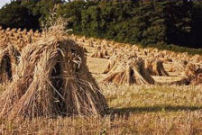 Harvested Wheat in stooks
Harvested Wheat in stooks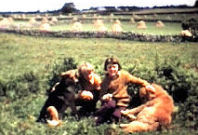 Martin & Michael - Tim & Speed 1974
Martin & Michael - Tim & Speed 1974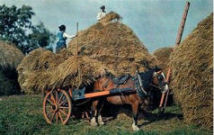 Haystacking in the haggard
Haystacking in the haggard 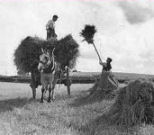 Taking oats to the haggard
Taking oats to the haggard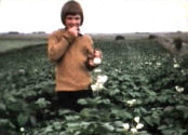 Drills of potatoes
Drills of potatoes